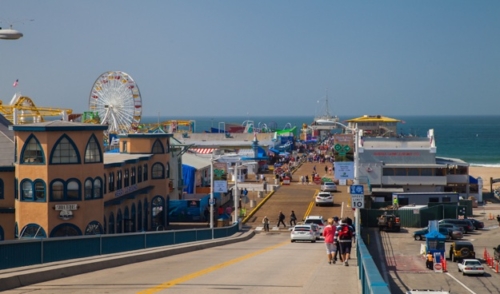Santa Monica Pier

- Known As
- The Pier
- Architect
- Charles Looff and others
- Built
- 1916
- Designated
- August 17, 1976
Santa Monica Pier was one of the earliest landmarks designated by the city, not so much because of its architectural distinction, but because it is a uniquely rich reminder of our city’s past.
Today’s Santa Monica Pier actually consists of two side-by-side piers with different origins. The longer, slender portion on the north side was built in 1909 as the Municipal Pier. Originally its function was to provide a conduit for the city’s sewage to be pumped out into the bay, though it was also a pleasant place to walk and fish. The southern portion of today’s pier, constructed in 1916, had an entirely different purpose. It was a “pleasure pier,” built by the amusement entrepreneur Charles Looff. (Looff was a remarkable man who had made his start in the amusement business carving merry-go-round horses. He installed his first carousel at Coney Island in 1875 and from there successfully developed amusement parks in several states.)
Pleasure piers, which were ubiquitous in Southern California in the early 20th century and considered state-of-the-art entertainment at the time, often featured dancehalls, theatres, restaurants, and thrill rides. In the days before air conditioning and television, people flocked to such piers to escape inland heat and boredom. Looff’s pier specialized in “refined” amusements, among which were a carousel housed in the marvelous Looff Hippodrome (still located on the pier today), a bandstand, a ballroom, a bowling and billiards hall, and rides including the Blue Streak roller coaster. In 1924, after the pier had been sold to another operator, the La Monica Ballroom was added on the west end of the pier. These attractions made the pier a great success and the years between 1916 and the Depression were its heyday.
Since these beginnings, the two piers have undergone many changes. After its initial years of great popularity, the amusement portion of the pier fell on hard times during the Depression. Business was slow in the 1930s and the pier’s management declared bankruptcy. The Municipal section of the pier, for its part, continued to see visitors who came for the fishing. In 1940, the federally-funded WPA built the bridge over PCH to the pier. In the same year, pier businessmen tried to drum up interest in the pier by erecting the arched sign that currently stands at the foot of Colorado Avenue. However, World War II soon intervened and the piers adapted to new uses. Some amusements continued, such as dances for servicemen and war workers at the La Monica, but the ballroom was also used as shelter for troops protecting the coast. No improvements were made to the pier during the war due to lack of materials and manpower.
In the years after World War II the pier still attracted fun seekers, particularly to dances with music by Western swing bandleader Spade Cooley, but the piers’ long-term future fell into doubt. By the early 1960s the La Monica Ballroom was declared a safety hazard and was razed. Different schemes to revive the pier were floated by both private businesses and the city, but the pier was seedy and declining fast. It was within this context that the city council voted to demolish both parts of the pier in the 1970s.
This vote changed much about city politics. Up until this time the city had been very pro-development. But the imminent destruction of the pier galvanized residents’ sense that too much of the city’s heart and soul was being lost. Locals rallied to save the pier and, in the process, began the movement towards historic preservation that continues to this day.
Responding to these new circumstances, the city purchased the Looff section of the pier. This gave the city control over Santa Monica Pier’s future and the process of repairing and updating the pier began. Unfortunately, these efforts were stymied by winter storms that severely damaged the pier in 1982 and 1983. However, repairs and restoration were completed in 1990 and the city continues to manage the pier as an evolving icon of life in Santa Monica. As one of the oldest wooden piers in the United States, as the last remaining amusement pier on the West Coast, and as a symbol of the essence of the city, Santa Monica Pier is truly an extraordinary landmark.
Sources:
- Fred E. Basten. Santa Monica Bay: Paradise by the Sea. Los Angeles: General Publishing Group, 1997.
- Ernest Marquez. Santa Monica Beach: A Collector’s Pictorial History. Los Angeles: Angel City Press, 2004.
- “94 and Standing Tall,” Santa Monica Mirror, Nov. 5-11, 2003.
- Santa Monica Landmarks Tour. Santa Monica: City Planning Division, 2004.
- Paula Scott. Santa Monica: A History on the Edge. Charleston SC: Arcadia Publishing, 2004.
- Staff Report on Santa Monica Pier. City Planning Division, Santa Monica.
- Jeffrey Stanton. Santa Monica Pier: A History from 1875 to 1990. Donahue Publishing: Los Angeles, 1990.
- Marvin J. Wolf and Katherine Mader. Santa Monica: Jewel of the Sunset Bay. Chatsworth CA: Windsor Publishing, 1989.